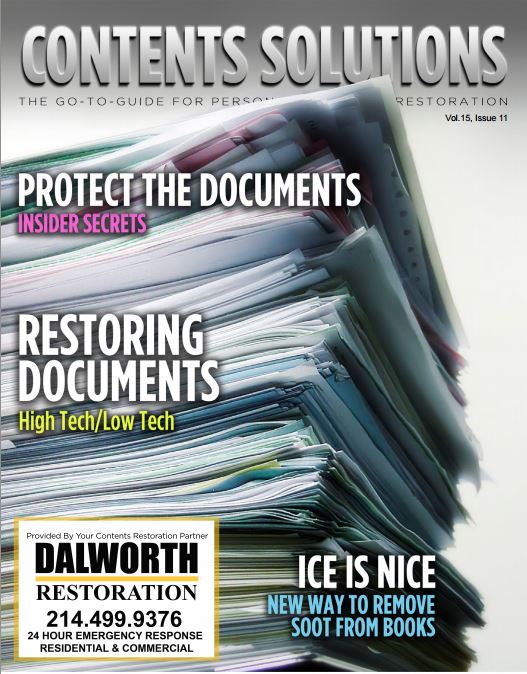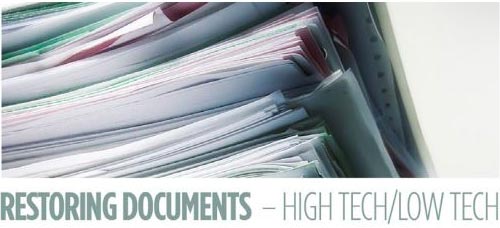24/7 Emergency Services
November 2015: Restoring Documents

The pack out of valued documents can be a very simple affair or a 
Normally, photographs are taken as a sort of “photo-inventory.” Notes are made as to where the documents came from and what sort of condition they were in before packing (smoke damaged, water damaged, etc.), then they are packed in sturdy boxes and moved to a safe location.
But what if the documents will be stored for an extended time and are of a fragile nature? What else should be done?
Fortunately, our mentors in the art and book restoration industries have shared their expertise. And the contents pros have made it their own.
The first thing we advise adjusters, agents and building managers to look for is a good, solid restoration company that uses packing and storage materials of such quality that they cause no further damage or increase the deterioration process.
For example, did you know that for long term “archive” storage, clear-colored, VOC-free, plastic containers are best? The reason is, some cases can have harmful, colored coatings that adversely affect valued documents and “off-gassing” can actually fade or discolor the information on the pages.
Contents pros will never use staples, paper clips or rubber bands on documents, photographs, stacks of invoices or loose book pages. If a collection has to be kept in order, folders, envelopes, un-dyed cotton string, or even archival tape may be used.
Archival tape is a tape that won't yellow or degrade over time and uses an adhesive that is “reversible.” That is, you can remove it with heat or a damp cloth depending on which type you purchase.
And they put no more than ten sheets of paper in the envelopes or folders. If the document is especially fragile, it may look wasteful, but the item may be placed in a folder all by itself.
For special projects, it is common to find the contents specialist protecting specific sheets one from the other with “buffered paper.” This is paper to which calcium carbonate (chalk) has been added to lower the acidity of the sheets of paper, the boxes then are packed with the spacers in between. This slows the deterioration and helps the paper last longer.
As an example, newspaper clippings are highly acidic and are often placed in “buffered” envelopes to help reduce their acidity when they are going to be in storage for an extended period.
Some photographs (usually colored as opposed to black-and-white) are better served by storing in unbuffered envelopes or folders. To make sure whether the document or photograph that is being stored is acidic or alkaline, a pH pen is often used by contents pros who are archiving valued documents.
Of course you know about media blasting. Restoration companies have used sand, soda and glass “beads” to clean away paint, oil, grease, asphalt, tar, decals, soot, dirt, ink, resins, carbon, adhesives – even metal slag from heavy machinery.
Now (historically speaking) there is a new “kid on the block.” We have written about it before – ice blasting. If you have read the past articles in Contents Solutions, you may know it as primarily a paint and mold remover – recently though, those who work with it have discovered something new.
They have found a way to remove soot from the pages of books with dry ice. But instead of calling it “dry ice blasting” they refer to this more gentle form of cleaning as “dry ice dusting.”
We've seen it in action and we are ready to give it a “thumbs up!” Almost magically, the “wand” is passed over the book cover and the sticky soot vanishes.
And best of all, the dry ice vanishes as well – no wet sludge or moisture left behind at all! The dry ice evaporates on contact!
Best of all, a Canadian study demonstrated, “...the certainty that dry ice dusting, when carefully applied, is less abrasive than traditional dry rubber sponge cleaning.”
COLD PLASMA AND PEROXIDE
After 9/11 and in answer to the anthrax attacks, a restoration and remediation company joined forces with DARPA (The Defense Advanced Research Projects Agency – the branch of the U.S. Department of Defense responsible for the development of emerging technologies for use by the military) to create a new technology that is EPA registered for use as “hospital-healthcare disinfectant.”
It looks to be about the size of an airline roll-on suitcase with a ray-gun attached by a small tube.
It uses Activated Ionized Hydrogen Peroxide (AIHP) – an 8% solution of peroxide, activated by “atmospheric cold plasma” (an electrical charge), and sprays out in a fine mist.
It kills just about any microbe (including mold) as long as it is on a hard surface. It takes as little as 5 seconds to apply and as little as 7 minutes contact time – and it is so localized that the hospital administrators don't even have to turn off the HVAC system.
This is no toy! The operators have to wear personal protection equipment and yet it is being used in hospitals, on cruise ships, in Army barracks and in family homes.
It even has a “remote control” that allows an operator to turn it on and off from a distance. Watch for it – we think we will be hearing from this new technology for quite some time to come.

So, how do you clean and restore valued papers or files that have gotten wet or are now impregnated with smoke odors, or have mold growing on them? Documents, such as tax records, loan agreements, passports, school transcripts, medical records, birth certificates and contracts are all included in this practically endless list.
In our modern digital age, you might think that if a document is damaged, why not just scan it into a computer, “clean it” in a program like Photoshop® and save all the hassle of trying to dry it out or remove the smoke malodors from it with foggers, freeze dryers or ozone?
One company had the opportunity to restore everything from 70,000 rare books and films from the Detroit Public Library and 40,000 architectural drawings from Marshall Fields Department Store in Chicago, to actual artifacts from the Titanic (think luggage claim stubs, and other paper documents). The owners weren't interested in getting photocopies of the originals – they wanted the originals themselves!
Contents professionals approach each case with the expectation that they will use “digital restoration” as a last resort. In most situations, they anticipate that they will be able to restore the actual documents or books.
In the case of fire, tightly packed file folders don't leave a lot of space for smoke to find its way in, most of the pages in such situations can be salvaged. Unfortunately, they still have a strong smell of smoke and will have to be thoroughly cleaned and deodorized.
As for wet books – you have read our articles about freeze-drying in other issues of Contents Solutions, so at the very least, you know that just freezing wet books and documents can actually help prevent any further damage and will halt any new mold growth (really, the contents specialists will actually just place them in an ordinary freezer to buy time). And, in the best case scenario, the freeze-drying process can restore the document to pre-loss condition.
And yes, even wet photographs can be restored if they are presented to the team in time.
Of course not all the answers lie with high tech equipment. We have seen highly successful restoration professionals using everything from hair dryers, to soot sponges and camel hair brushes in order to complete document assignments. It all depends on the worth of the item in question.
NOT-SO-RARE BOOKS?
Contents professionals aren't usually expert rare book restorers. They are, however, most resourceful. So, if the insured had an old, leather bound book that the adjuster had established was not worth sending to a conservator (but still had some value to the client), let's take a look at what a contents pro might do.
First of all, they won't do anything that might reduce the worth of the book any more than it already was.
Second, they have soot sponges and a substance called, “Absorene” that looks like pink Playdoh® and is actually used by museums to clean their books. So the contents specialists can do a professional job of cleaning.
Third, they have leather creams, lotions and dyes that can restore the color and luster to the cover.
And finally, they can remove the smoke odors (if there are any).










